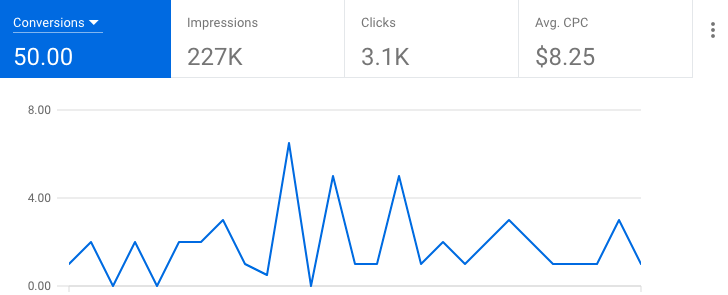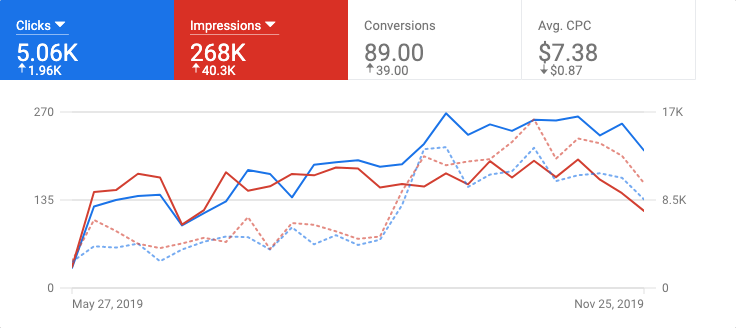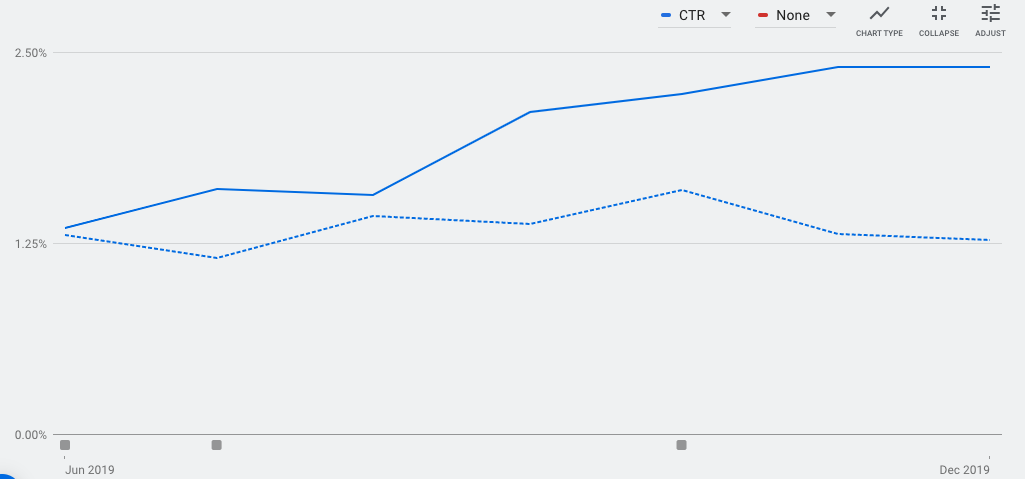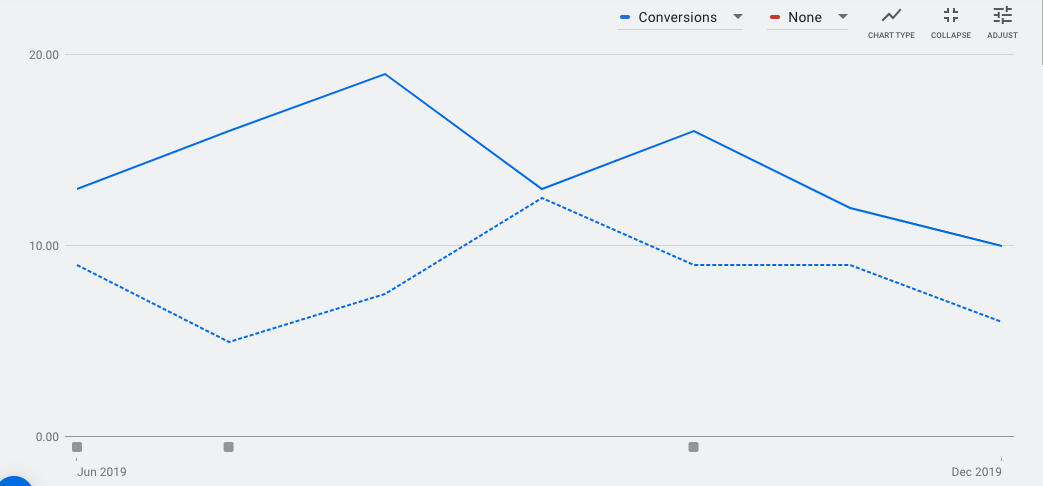Adwords Case Study How 4 Simple Tweaks Led to 78% More Conversions
This Colorado-based software development company had a history of running pay-per-click campaigns but without great success. We needed to enable accurate ROI tracking from Google Adwords spend.
As the contract with their previous pay-per-click (PPC) marketing agency ended, we took over the account and found several ways to drastically improve.
MAIN GOAL: INCREASE LEAD VOLUME AND QUALITY
In order to get more leads, we needed to assess what wasn’t working. There were four main problems:
1. Poor conversions on the website
Many people clicked on the ads, but few people took the time to fill out the form. Getting more people to “convert” into leads drastically increased the effectiveness of ad spend.
2. No micro-conversion opportunities
Sometimes, people aren’t ready to become a customer. You need to provide some value to them (an ebook, guide, webinar, etc.) and start building a relationship. The company didn’t have any relationship-building strategies in place.
3. Unable to track conversions across different platforms
As the great management consultant Peter Drucker once said, “What gets measured, gets managed.” This client did not have an effective measurement strategy in place. This made it difficult to manage the ad spend.
4. Lack of PPC optimization
Finally, the account was missing some standard PPC optimizations. Simple changes had a big impact on account effectiveness.
PROBLEM 1: POOR WEBSITE CONVERSIONS

The previous PPC strategy sent traffic to a basic “Contact Us” page. It had a contact form, but it was a missed opportunity for creating a high-converting page.
What elements do all high-converting pages have?
- Attention-grabbing headline
- Clear definition of the client problem
- Solution to the problem
The client website had none of these key elements.

Solution: Create relevant, dedicated landing pages for visitors to land after clicking the ads.
Generic pages don’t convert well.
So we scrapped the “Contact Us” page and instead used specific, tailored ad copy to ensure message match across the funnel.
We stopped explaining the features and focused on benefits:
Do More With Us → Work with developers in your time zone to deliver faster results.
That’s a focused call-to-action and simple explanation of benefits. This simple fix caused conversions to skyrocket.
PROBLEM 2: NO MICRO-CONVERSION OPPORTUNITIES
Our client was using the “Contact Us” landing page as the only form of lead generation.
But this is a big ask.
What about visitors who aren’t ready to reach out?
What if they are “just browsing”? How do we engage with them?
M I C R O – C O N V E R S I O N S.
Micro-conversions are small actions visitors take on a website. This includes exchanging contact info (like name and email) for a piece of valuable content.
These small actions put visitors into the sales and marketing pipeline — even if they aren’t ready to purchase yet. They entice people to raise their hand as a future potential client.

Why is this important for B2B?
Not only does giving value upfront establish trust, but it also allows us to build a customer journey for leads who were not ready to convert right now. We can now better guide each step a customer takes until converting.

Solution: downloadable PDFs of whitepapers or webinars and put them behind an email wall.
But these aren’t any old whitepapers.
We did deep dives into specific topics leaving readers with a clear understanding of the:
- Problem at hand
- Research data and its context
- Keys for successful implementation
This strategy helped us collect leads without asking visitors to contact us first.
PROBLEM 3: NO TRUE WAY TO TRACK CONVERSIONS ACROSS MULTIPLE PLATFORMS
Our client had basic conversion metrics from Google Analytics, but couldn’t link exact ads to exact leads within their CRM platform.
We needed to ensure attribution was accurate across multiple platforms including:
- Google Ads & Analytics
- Hubspot CRM
- Salesforce CRM

Solution: Create a proprietary tagging system with UTM codes to track the customer journey

Why are UTMs important?
It gives a clear view of where traffic was coming from. We can see the campaign, source, and medium.
Not only that, but it also enables us to pinpoint the exact ad each user saw.
So we’re able to answer our client’s questions:
- Where is the traffic coming from?
- How does it get here?
- Why is it coming here?
Accurate tracking allows us to measure our work, so we know how big (or little) of an impact we’re making.
PROBLEM 4: LACK OF ADVANCED PPC OPTIMIZATION
You’ll notice all of this happened even before we started to optimize the PPC campaign. Great lead generation is not just about PPC optimization — it’s about the whole funnel.
With Google Ads, it’s tempting to just “set it & forget” but this can hurt campaigns.
Competitors, budgets, the market, and search behavior are constantly changing. We must be vigilant in optimizing the campaign to always have the best chance to generate more quality leads at a lower cost.

Multiple Solutions: Including negative keywords, continual refining, and testing
1. Add a ton of negative keywords, so we don’t waste money with ads showing for unrelated terms.
2. Refine demographics based on age and location, so we can pinpoint and target our key market audience.
3. Constantly test new keywords so that we find the right, high-intent keywords, and phrases to lead to conversions.
4. A/B test landing pages so we can make data-driven decisions on which messaging works best.
5. Refine and test bidding strategies so that we can maximize ROI of campaigns.
6. Work with the client to develop ad copy so that they can convert while meeting their brand standards.
FINALLY – THE MASSIVE RESULTS!
In just six months, we were able to see huge increases across the board.


From June – Dec 2019 vs Nov 2018 – May 2019 (6 months)
CTR: +39%


Conversions: +78%


A 39% increase in CTR means we were attracting the right visitors.
And when the right kind of visitors click on our ads and get a highly targeted landing page, our conversion rates shoot up — in this case, to 78%.
It’s easy to run a PPC campaign, focusing on keywords or ad copy. But it’s more than that.
It requires a high-level view of the entire lead gen strategy.
Where are prospects in the sales funnel? Do these keywords match intent?
Great campaigns aren’t just “running ads.” They are about meeting the prospect where they are and leading them into a relationship with your brand at the speed they are content with.